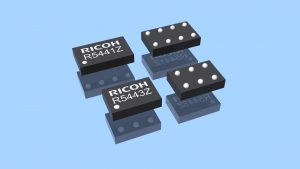Li-Ion battery ICs in WLCSP
 Ricoh has launched single cell Li-Ion battery protection ICs in a Wafer Level Chip Scaled Package (WLCSP).
Ricoh has launched single cell Li-Ion battery protection ICs in a Wafer Level Chip Scaled Package (WLCSP).
They are especially designed for use in rechargeable smart watches, hearing aid instruments, fitness trackers, wireless earbuds and other small portable devices.
Wearable devices incorporate a small rechargeable Li-Ion battery with a capacity in the range from 50 to 100 mAh and have new challenging requirements for its internal components, like an ultra-small package size, low current consumption in On and Standby mode but also sophisticated safety circuits.
The R5441 and R5443 fully comply with these requirements.
The R5443 is the smallest version and has a board space areaof 1.05 mm2 and a thickness of 0.36 mm, it is considered as one of the smallest single cell Li-Ion protection ICs available today. It is around 53% smaller compared to the popular protection ICs in a 1.4 x 1.4mm DFN package.
Significant detail for the R5441 / R5443 is that the current consumption of the ICs is equal or lower thanmost other available solutions on the market and contributes reducing the self-discharge rate of the batterypack. In normal operation, the current consumption is respectively 3.5 µA and 2.5 µA.
As soon the batteryvoltage decreases below the over-discharge voltage threshold, the product enters a standby mode and disables several internal circuits to lower the current consumption to 0.04 µA, ensuring further discharge of the battery is kept to a minimum.
Li-Ion batteries are safe in general when used according to the specifications but can become a potentialhazard in case of an internal or mechanical malfunction.
Overheating, emitting fumes or even worse can be the result; therefore, the protection IC monitors the charge and discharge process and interrupts as soon theprocess is at risk of going beyond the safe operation range of the battery cell. The following processes are monitored:
• Over-charge voltage: Battery voltage exceeds the charge threshold for a certain period. • Over-discharge voltage: Battery voltage exceeds the discharge threshold for a certain period. • Over-discharge current: Battery current exceeds the discharge threshold for a certain period. • Over-charge current: Battery current exceeds the charge threshold for a certain period. • Short current: Battery current exceeds the short discharge threshold for a certain period.Both the R5441 and R5443 have an improved over-charge voltage threshold accuracy of ±10 mV versus ±30 mV for regular products. The idea behind this feature is to increase the charge voltage whilstmaintaining the same safety level. As a result, the battery voltage will increase with 40 mV and extends thebattery lifetime, which is important for applications with a small battery capacity.
Traditionally one makes use of the MOSFET on-resistance in order to measure the current flow of the batterypack. However, the on-resistance level is most inaccurate as it depends on various criteria such as ambienttemperature, gate voltage and MOSFET type.
In order to achieve a higher standard of current sensing, theR5441 and R5443 make use of an external current sense resistor.
Such resistor can be ordered with your preferred resistance value and accuracy level. The great advantage of using an external resistor is that theover-current threshold margin improves significantly in comparison to the MOSFET current sense method.
The R5441 has an additional circuit to monitor the temperature of the battery pack by connecting an externalNTC resistor to the Tin pin. In case of an over-temperature event, the charging or discharging process isinterrupted.
It is possible to set different temperature threshold settings for the over-charge and over-discharge threshold.
